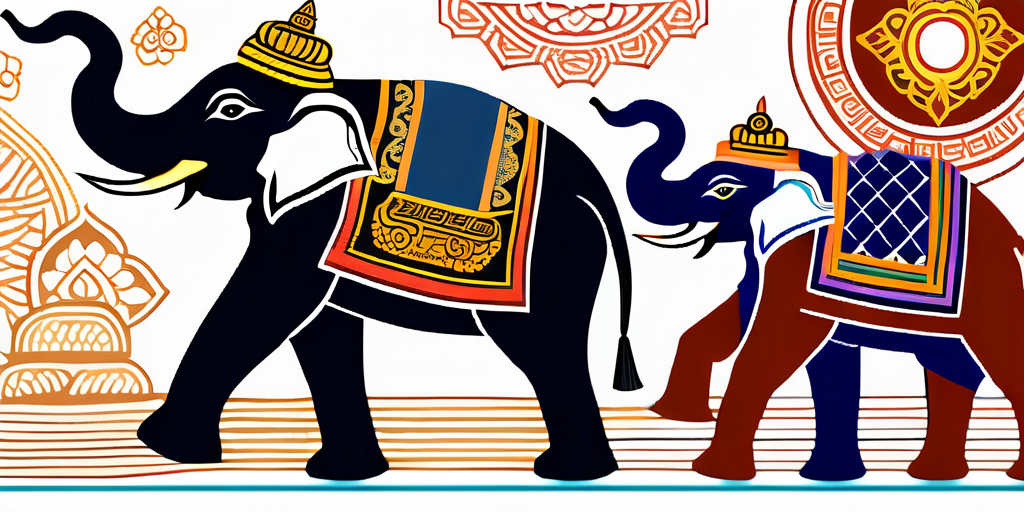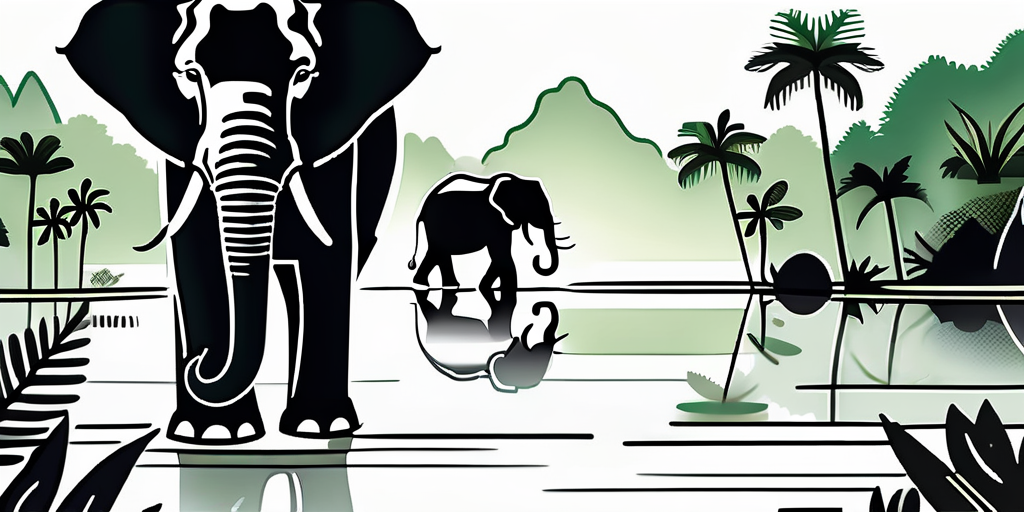Despite limited funds, Thai people are determined to protect their elephants.
Thailand is a country known for its rich culture, breathtaking landscapes, and majestic wildlife. Among its many treasures, the elephant holds a special place in the hearts of the Thai people. Despite facing financial challenges, their determination to protect these magnificent creatures remains unwavering.
Understanding the cultural significance of elephants in Thailand
Elephants have had a profound spiritual and historical connection with Thai people for centuries. Revered as sacred animals, they are deeply integrated into Thai folklore, tradition, and religious ceremonies.

Thailand, known as the “Land of Smiles,” is a country rich in cultural heritage and traditions. From its vibrant festivals to its majestic temples, every aspect of Thai culture reflects a deep reverence for the natural world. Among the many creatures that hold a special place in the hearts of the Thai people, elephants stand out as symbols of wisdom, strength, and good luck.
The spiritual and historical connection between Thai people and elephants
In Thai culture, elephants are considered a symbol of wisdom, strength, and good luck. They are believed to bring prosperity and protection to communities. Historically, elephants played a crucial role in warfare, transportation, and even in religious processions.
The spiritual connection between Thai people and elephants can be traced back to ancient times. Thai folklore and mythology are filled with captivating stories of these magnificent creatures. It is believed that elephants possess a unique spiritual energy that can bring blessings and ward off evil spirits.
Throughout history, elephants have been revered as sacred animals and have held a special place in the hearts of Thai people. They have been regarded as a symbol of power and authority, often associated with the monarchy. The Thai national flag features a white elephant, known as Chang Thai, which represents strength, endurance, and resilience.
Elephants in Thai folklore and tradition
Thai folklore is filled with enchanting tales of elephants, reflecting the admiration and respect they hold in Thai society. Stories of brave and intelligent elephants have been passed down through generations, capturing the imagination of both young and old alike.
One popular folktale tells the story of a wise elephant named Plai Klong, who possessed extraordinary intelligence and strength. According to the legend, Plai Klong helped a young prince overcome numerous challenges and ultimately led him to victory. This story not only highlights the intelligence and loyalty of elephants but also emphasises the importance of wisdom and perseverance in Thai culture.
In addition to folklore, elephants play a significant role in traditional Thai ceremonies and festivals. During the annual Elephant Festival, held in Surin province, elephants are beautifully adorned with vibrant colours and intricate designs. The festival showcases the close bond between elephants and their mahouts (handlers) and celebrates the cultural heritage of these majestic creatures.
Elephants have also been an integral part of Thai agriculture for centuries. In rural areas, elephants were used for ploughing fields, transporting goods, and even as a means of transportation for the royal family. Their immense strength and gentle nature made them ideal companions for farmers and villagers.
Today, efforts are being made to protect and conserve elephants in Thailand. Conservation projects and sanctuaries have been established to provide a safe and natural habitat for these magnificent creatures. These initiatives not only aim to preserve the cultural significance of elephants but also to raise awareness about the importance of wildlife conservation.
The current plight of elephants in Thailand
Unfortunately, the modern-day reality for Thai elephants is far from idyllic. They face numerous challenges that threaten their very existence.

Elephants, the gentle giants of the animal kingdom, have long been revered in Thai culture. They symbolise strength, wisdom, and prosperity. However, in recent years, these magnificent creatures have been pushed to the brink of extinction due to various factors.
The impact of tourism on Thai elephants
Tourism has both positive and negative consequences for Thai elephants. While it provides an opportunity for people to appreciate these majestic animals up close, the sheer volume of visitors can place immense stress on elephants.
Imagine a typical day in the life of a Thai elephant living in a popular tourist destination. From dawn till dusk, they are subjected to a constant stream of curious onlookers, eager to capture the perfect selfie or experience an elephant ride. The noise, commotion, and constant human interaction can be overwhelming for these gentle giants, who are naturally accustomed to a more serene and peaceful existence.
Riding camps, once a popular attraction, have come under scrutiny for their impact on elephant welfare. These camps often use controversial training methods, such as the use of bullhooks and chains, to control and manage the elephants. These practices have raised concerns among animal welfare organisations, who argue that such methods are inhumane.
Furthermore, the living conditions in some of these camps are far from ideal. Elephants are social animals, accustomed to living in close-knit family groups in the wild. However, in captivity, they are sometimes kept in small enclosures, isolated from their natural habitat and deprived of the social interactions they crave. This is often due to the lack of knowledge or resources of the mahouts rather than purposeful mistreatment due to the cultural affiliation with elephants we’ve already discussed, which STEF works to support – however we acknowledge that direct cruelty does of course exist as well.
The threat of poaching and illegal trade
Poaching and illegal trade remain persistent threats to Thai elephants. The demand for ivory and the exploitation of elephants for entertainment have fueled the black market, putting these majestic creatures at risk.
Thailand, once known as the “Land of the White Elephant,” has a long history of elephant poaching. In the past, elephants were hunted for their ivory tusks, which were highly valued in the global market. Despite efforts to combat these activities, the illegal ivory trade continues to thrive, driven by the insatiable demand for this precious commodity.
Not only are elephants targeted for their ivory, but they are also exploited for entertainment purposes. The practice of using elephants in circuses, street performances, and other forms of entertainment has been widely criticised for its detrimental impact on elephant welfare. These performances often involve cruel training methods and unnatural living conditions, causing immense physical and psychological suffering for the elephants involved.
Efforts have been made to address these issues and protect Thai elephants. Conservation organisations, both local and international, are working tirelessly to raise awareness, enforce stricter regulations, and provide alternative livelihoods for those involved in the illegal trade.
However, the battle is far from over. It requires a collective effort from governments, communities, and individuals to ensure the survival and well-being of Thai elephants. By supporting ethical tourism practices, advocating for stronger legislation, and promoting education about elephant conservation, we can all play a part in securing a brighter future for these magnificent creatures.
The financial challenges in elephant conservation
One of the key obstacles to protecting Thai elephants is the limited availability of funds.
Elephants, the majestic creatures that they are, face numerous challenges in their survival. From habitat loss to poaching, their existence is constantly under threat. However, one of the most pressing issues that hinders elephant conservation efforts is the financial aspect.
Limited government funding for elephant protection
The Thai government, like many others, faces numerous competing priorities. With limited financial resources, it becomes challenging for them to allocate sufficient funds for elephant protection initiatives. As a result, the budget allocated for the conservation of these magnificent animals remains minimal.
While the government recognises the importance of elephant conservation, it is often constrained by its financial limitations. The lack of adequate funding not only affects the implementation of conservation projects but also hampers the efforts to address other pressing issues such as habitat restoration and anti-poaching measures.
The role of non-profit organisations in filling the funding gap
Non-profit organisations like STEF have stepped up to fill the funding gap in elephant conservation efforts in Thailand. These organisations, driven by their passion for wildlife conservation, play a crucial role in supporting various initiatives aimed at protecting elephants.
Through their tireless fundraising activities, non-profit organisations provide the much-needed financial resources for a wide range of projects. These include the establishment and maintenance of rescue and rehabilitation centres, funding anti-poaching patrols, and supporting community-led projects that promote coexistence between humans and elephants.
These organisations work tirelessly to raise awareness about the plight of elephants and the importance of their conservation. They organise events, campaigns, and educational programs to engage the public and garner support for their cause. By mobilising resources and collaborating with local communities, they strive to create a sustainable future for elephants in Thailand.
However, the reliance on non-profit organisations for funding raises concerns about the long-term sustainability of elephant conservation efforts. While their dedication and efforts are commendable, the responsibility of protecting these magnificent creatures should not solely rest on their shoulders. It requires a collective effort from governments, businesses, and individuals to ensure the survival of elephants for future generations.
In conclusion, the financial challenges in elephant conservation are significant. Limited government funding and the reliance on non-profit organisations highlight the need for a more comprehensive and sustainable approach to address these challenges. By prioritising the allocation of funds and fostering partnerships between various stakeholders, we can work towards securing a brighter future for Thai elephants.
Grassroots efforts to protect Thai elephants
Amidst the financial challenges, local communities have taken it upon themselves to protect Thai elephants and preserve their natural habitats.
Community-led conservation initiatives
Across Thailand, communities living near elephant habitats have initiated conservation projects. These initiatives promote sustainable practices, encourage responsible tourism, and educate locals and visitors alike on the importance of preserving these majestic creatures.
Innovative fundraising strategies for elephant protection
To overcome the financial barriers, innovative fundraising strategies have emerged. From crowdfunding campaigns to creative collaborations with local artists and businesses, these initiatives aim to generate much-needed funds for elephant conservation.
The future of elephant conservation in Thailand
As the challenges persist, various solutions and long-term visions are being proposed to secure the future of Thai elephants.
Potential solutions to the funding problem
Efforts are underway to explore alternative funding sources, including public-private partnerships and government incentives for companies with a commitment to elephant conservation. By diversifying funding streams, there is hope for a more sustainable future for Thai elephants.
The long-term vision for Thai elephant conservation
The long-term vision for Thai elephant conservation involves strengthening regulations, promoting ethical elephant tourism, supporting research and conservation projects, and empowering local communities to take an active role in protecting these majestic creatures.
Despite the financial challenges, the Thai people remain resolute in their commitment to protect their beloved elephants. While there is still much work to be done, their determination, combined with the efforts of non-profit organisations and grassroots initiatives, gives hope for a brighter future where elephants continue to roam free in Thailand’s majestic landscapes.

